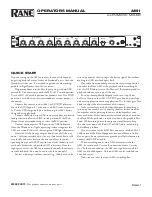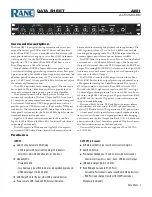
30
Chapter 4: Advanced Mixing Tutorial
ProMix 01 Getting Started Guide
Where to Go from Here?
That’s the end of the tutorials. In the Basic Tutorial you leaned how
to set input levels, apply EQ, use the EQ library, set CUE modes, set
faders, use the [ON] buttons, and set the pan. You should now have
a good understanding of ProMix 01’s basic mixing functions. In the
Advanced Tutorial you leaned how to apply, recall, edit, and store
effects; patch in a dynamics processor; and store and recall mix scenes.
After working with just one input channel, you’re probably ready to
start mixing for real. Connect several sound sources and start mixing
using the techniques that you’ve learned. If you’re relatively new to
audio mixing, see “General Mix Procedure” on page 42.
The system examples in the next chapter show ProMix 01 in action
in some real-life working applications. They include: live perfor-
mance, onstage keyboard mixing, MIDI studio, and multitracking.
You can, of course, pick-and-mix your system components to match
your exact requirements.
Although you’ve covered a lot of ground with ProMix 01, the fun is
really only just beginning. Remember that full MIDI control allows
you to recall mix scenes and control all mix parameters in real time.
All you need is a MIDI sequencer. See page 45 to find out how to set
up a ProMix 01 automation system. Otherwise, proceed to the User’s
Guide for a full explanation of all ProMix 01 functions—happy
mixing.
















































